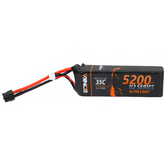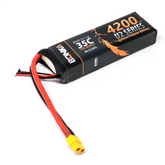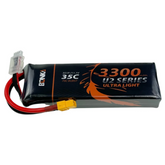LiPo Batteries & Drones
Summary
Drones have revolutionized industries, from photography to agriculture. But what fuels these flying marvels? Our blog, "LiPo Batteries & Drones," delves into the heart of drone power sources. Discover why LiPo batteries have become the go-to choice, explore other battery types such as Nickel Metal Hydride and Alkaline cells, and even consider unconventional options like Lead Acid packs. From lightweight efficiency to power-packed performance, this blog takes you through the thrilling world of drone batteries. Don't miss the conclusion, where we weigh the pros and cons, helping you make the right choice for your drone adventures. Click here to power up your knowledge!
Why LiPo battery is used in drones?
Lipo batteries are used in drones for a vast array of reasons. They offer extraordinary energy density and unsurpassed performance when compared to other commonly used battery types, making them an ideal choice for powering any drone model. When combined with the lightweight construction of these types of cells, it makes lipo batteries perfect for keeping drones aloft without adding too much extra weight or bulk that could reduce their manoeuvrability. Additionally, they provide a high level of current output which helps keep your drone at peak performance during extended flights as well as enabling more consistent power throughout each flight session due to having greater voltage stability over larger temperature ranges than standard NiCd and NiMH rechargeable cell technologies can achieve. Furthermore, Lipos have superior reliability since there is no memory effect on their life span meaning you get maximum usage out every charge cycle time after time so you won't need to replace them often as older disposable models do require from time to time. With all those benefits packed into one package – plus the ease in managing charging within minutes - it's little wonder why many professional users opt for advanced lipo-powered unmanned aerial vehicles (UAV) systems above any other type available today!
Choose the powerful 2200mAh LiPo Battery for better performance.
read more: Where to Buy Drones in India

Different types of batteries used in drone
- Lithium Polymer (LiPo) Batteries: These are the most common type of battery used in drones due to their lightweight and powerful output. LiPos come in a variety of capacities, voltages, and discharge rates; offering flexibility for customizing your drone power system.
- Nickel Metal Hydride (NiMH): NiMh batteries offer an excellent combination of weight-to-power performance when compared with traditional Nicd packs but do not have quite as much punch as Lipos provide making them suitable only on smaller multirotor models or larger fixed-wing planes where low-speed applications are necessary such as photography flights without require too much current draw from motor systems.
- Alkaline Cells: Smaller toy-grade drone designs often use inexpensive dry cell alkaline cells instead because it is easy to buy multiple preloaded sets at local retail stores especially since many parks like AAAAaaatvTrails use these types which can be swapped out quickly if needed while flying outdoors.
- Lead Acid Packs: For large-scale commercial RC aircraft, there remain some lead acid-based approaches still being pursued although they tend historically towards more expensive “hotel” installations rather than mobile ones so fuel efficiency here usually isn't an advantage over high-quality LiPo options that can be installed directly onto profession level vehicles safely after required flight testing has been completed prior takeoff attempts by piloting teams following established safety protocols.
read more : What are drones? A-Z Guide Of Assembly to Flying
Lithium Polymer (LiPo) Batteries for drones
Lithium Polymer (LiPo) batteries are the go-to power source for many commercial and recreational drones, providing a lightweight solution to powering up these popular aircraft. LiPo packs offer high energy density in an easily transportable package; they are light enough to be carried on your person without creating too much strain or discomfort. Furthermore, their ability to deliver consistent levels of current provides reliable performance even when subjected to extreme temperatures or conditions.

These rechargeable cells provide superior cycle life compared with other types of traditional drone battery technologies such as nickel metal hydride NiMH or lead acid solutions, meaning fewer trips back home due to low charge after extended flights. With built-in circuit protection also included from most manufacturers that prevent overcharge/discharging scenarios often seen during typical flight situations – LiPo batteries have become increasingly popular across both professional and hobbyist pilots alike!
read more : Drone Motor Maintenance: Tips to Keep Your Motors Running
Nickel Metal Hydride Batteries for drones
Nickel Metal Hydride (NiMH) batteries are a popular choice for powering drones. They offer superior performance when compared to traditional alkaline or lithium-ion cells, as they provide higher energy density and greater discharge rates than other battery types. NiMH also has excellent rechargeability and is environmentally friendly due to its low self-discharge rate of around 1% per month at room temperature. Additionally, these batteries can be recharged up to 1000 times with no significant decrease in capacity making them incredibly cost effective over the long term.

When it comes time for you to select the right power source for your drone then look no further than Nickel Metal Hydride! With improved safety features like short circuit protection and internal current fuse cutting-off function available on many models, these advanced battery systems provide reliable high output without compromising quality or longevity - not to mention one of the best weight/energy ratios out there! So if you're looking for consistent flight performance that only NiMh delivers - upgrade today – your sky explorer awaits!
read more : How drone works?
Alkaline Cells for drones
As drones become increasingly popular, their need for power is greater than ever. Alkaline Cells offer an ideal solution as they boast superior energy density and long lifecycles when compared to other primary batteries on the market today.
Alkaline cells are a type of non-rechargeable battery that contains zinc/manganese dioxide electrodes in alkaline electrolytes such as potassium hydroxide or sodium hydroxide.

This combination provides excellent performance characteristics which make these types of batteries perfect for powering drones over extended periods while ensuring high levels of reliability at all times. What’s more, since they have been thoroughly tested and proven to be reliable even after years of use, you can trust them with your drone's mission-critical operation time after time without fear of any malfunctioning due to low cell voltage or corrosion from environmental factors! Additionally, because they’re made out entirely of recyclable materials; using alkaline cells helps minimize our impact on the environment too – leaving us feeling good about protecting it whilst getting great results every time we get airborne!
read more : How to make quadcopter using Arduino
Lead Acid Packs for drones
Lead-acid packs are the ideal choice for powering professional drones. These advanced power systems offer reliable energy storage, eliminating frequent battery replacements and providing an excellent balance of performance and endurance.
Highly efficient and long-lasting, lead acid batteries provide outstanding cycle life - up to four times longer than their lithium counterparts – with rapid charge capabilities that enable users to quickly get back in the air! In addition, these durable batteries have a low self–discharge rate so they can be stored away for extended periods without full discharge or damage — perfect when you need your drone at short notice during busy production seasons.
Built from robust components with military-grade protection against shock & vibration that prevents contact breaking down due to marching parts movement over time — ensuring maximum power output is always guaranteed! Quick swap designs allow users to rapidly switch between multiple pre-charged packs; allowing them to keep operating uninterrupted throughout even the busiest filming days on set locations outdoors where environmental conditions can change drastically within minutes.
read more : Safe Disposal of Batteries
Conclusion
The choice of batteries for drones is not a one-size-fits-all decision. We've delved into the fascinating world of drone power sources, exploring the versatility and efficiency of LiPo batteries, the reliability of Nickel Metal Hydride cells, the convenience of Alkaline cells, and the durability of Lead Acid packs. Each type has its own strengths and weaknesses, catering to different drone applications. Whether you're a hobbyist or a professional pilot, understanding the battery options available is essential for maximizing your drone's performance. So, next time you take to the skies, remember that the right battery can make all the difference in your drone's flight experience. Make an informed choice and power up for your next adventure!
If you appreciate our work don't forget to share this post and leave your opinion in the comment box.
Please do check out other blog posts about Popular electronics
Check out other related blog posts about Drones: Drone transmitter and receiver , Drone Part List , Drone motors and Getting started with a Quadcopter
Make sure you check out our wide range of products and collections (we offer some exciting deals!)










